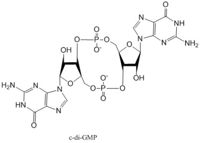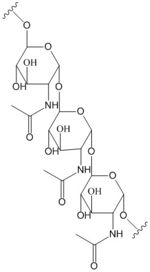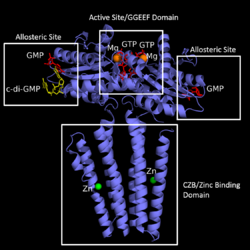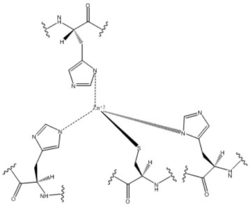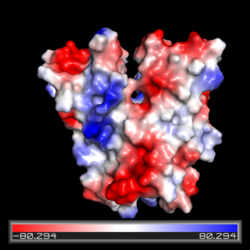Sandbox Reserved 1072
From Proteopedia
(Difference between revisions)
| Line 6: | Line 6: | ||
[[Image:C-di-GMP.jpg |200 px|thumb|left|cyclic-dimeric-GMP]] | [[Image:C-di-GMP.jpg |200 px|thumb|left|cyclic-dimeric-GMP]] | ||
[[Image:Poly B-1,6 GlcNAc.jpg |150 px|left|thumb|poly-β-1,6-N-acetylglucosamine]] | [[Image:Poly B-1,6 GlcNAc.jpg |150 px|left|thumb|poly-β-1,6-N-acetylglucosamine]] | ||
| - | Diguanylate cyclases are a group of class 2 transferase enzymes that catalyze the production of cyclic dimeric-guanosine monophosphate (c-di-GMP), an important second messenger for <span class="plainlinks">[https://en.wikipedia.org/wiki/Signal_transduction signal transduction]</span>. Signal transduction is the process of sending signals through cells to promote responses, most commonly through phosphorylation or dephosphorylation events. <span class="plainlinks">[https://en.wikipedia.org/wiki/Escherichia_coli ''Escherechia coli'']</span>, a gram-negative bacterium often found in the intestines of mammals, uses DgcZ in the synthesis of its <span class="plainlinks">[https://en.wikipedia.org/wiki/biofilm biofilm]</span>. Enzyme DgcZ from ''E. coli'' acts a catalyst to synthesize cyclic di-GMP from two substrate guanosine triphosphate (GTP) molecules to aid in communication of signals throughout the bacteria. C-di-GMP is a second messenger in the production of poly-β-1,6-N-acetylglucosamine (poly-GlcNAc), a polysaccharide required for ''E. coli'' biofilm production. This biofilm allows ''E. coli'' to adhere to extracellular surfaces. The DgcZ protein has C2 symmetry composed of two domains: the catalytic glycine-glycine-glutamate-glutamate-phenylalanine (GGEEF) domain responsible for synthesizing c-di-GMP and the regulatory chemoreceptor zinc binding (CZB) domain comprising two zinc binding sites. DgcZ binds zinc with sub-femtomolar affinity. When zinc is bound, the CZB and GGEEF domains adopt conformations that inhibit DgcZ function <sup>[1]</sup>. | + | Diguanylate cyclases are a group of class 2 transferase enzymes that catalyze the production of cyclic dimeric-guanosine monophosphate (c-di-GMP), an important <span class="plainlinks">[https://en.wikipedia.org/wiki/Second_messenger_system second messenger]</span> for <span class="plainlinks">[https://en.wikipedia.org/wiki/Signal_transduction signal transduction]</span>. Signal transduction is the process of sending signals through cells to promote responses, most commonly through phosphorylation or dephosphorylation events. <span class="plainlinks">[https://en.wikipedia.org/wiki/Escherichia_coli ''Escherechia coli'']</span>, a gram-negative bacterium often found in the intestines of mammals, uses DgcZ in the synthesis of its <span class="plainlinks">[https://en.wikipedia.org/wiki/biofilm biofilm]</span>. Enzyme DgcZ from ''E. coli'' acts a catalyst to synthesize cyclic di-GMP from two substrate guanosine triphosphate (GTP) molecules to aid in communication of signals throughout the bacteria. C-di-GMP is a second messenger in the production of poly-β-1,6-N-acetylglucosamine (poly-GlcNAc), a polysaccharide required for ''E. coli'' biofilm production. This biofilm allows ''E. coli'' to adhere to extracellular surfaces. The DgcZ protein has C2 symmetry composed of two domains: the catalytic glycine-glycine-glutamate-glutamate-phenylalanine (GGEEF) domain responsible for synthesizing c-di-GMP and the regulatory chemoreceptor zinc binding (CZB) domain comprising two zinc binding sites. DgcZ binds zinc with sub-femtomolar affinity. When zinc is bound, the CZB and GGEEF domains adopt conformations that inhibit DgcZ function <sup>[1]</sup>. |
== Structural Overview == | == Structural Overview == | ||
Revision as of 17:22, 14 April 2017
| This Sandbox is Reserved from 02/09/2015, through 05/31/2016 for use in the course "CH462: Biochemistry 2" taught by Geoffrey C. Hoops at the Butler University. This reservation includes Sandbox Reserved 1051 through Sandbox Reserved 1080. |
To get started:
More help: Help:Editing |
Diguanylate Cyclase DgcZ from Escherichia coli
| |||||||||||
